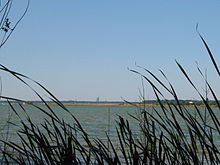Cospuden opencast mine
| Cospuden opencast mine | |||
|---|---|---|---|
| General information about the mine | |||
| Mining technology | Open pit mine on 3.2 km² | ||
| Overburden | 87 million tons | ||
| Information about the mining company | |||
| Start of operation | 1981 | ||
| End of operation | 1991 | ||
| Successor use | Replenishment to the Cospudener See | ||
| Funded raw materials | |||
| Degradation of | Brown coal | ||
| Geographical location | |||
| Coordinates | 51 ° 15 '55.4 " N , 12 ° 20' 6.6" E | ||
|
|||
| local community | Markkleeberg , Leipzig | ||
| District ( NUTS3 ) | Leipzig | ||
| country | Free State of Saxony | ||
| Country | Germany | ||
| District | Central German lignite district | ||
The Cospuden opencast mine was an operation for the extraction of lignite in the central German lignite area in Saxony .
Geographical location
The Cospuden opencast mine was located in the south of the city of Leipzig, north of the Zwenkau opencast mine . He belonged to the Borna district . The post-mining landscape is now partly in the area of the city and the district of Leipzig . Today the Cospudener See is located on the recultivated area , to the north is the preserved Leipzig alluvial forest .
Revelation story
As a result of the oil crises , the GDR sought maximum use of domestic lignite from the mid-1970s, which led to a radical policy of carbonisation. The open pit Zwenkau had from 1974 to 1980 the area south of the line connecting Zöbigker - Knauthain dismantled and went further to the west. Between Markkleeberg and the southwestern districts of Leipzig, however, there was a favorable coal field under the Leipzig floodplain forest, which had one of the most favorable conditions of this kind in central Germany with a ratio of waste mass to recoverable coal of 2.7: 1.
Regardless of the associated environmental damage, the opening of the new open-cast mine began in April 1981 from the northern embankment of the Zwenkau opencast mine. Coal extraction from the two seams , which were between eight and twelve and two and ten meters thick , started in August 1981. The overburden was transported (from 1983) by a conveyor belt , while the coal was transported by a train. The Cospuden opencast mine was closely connected to the Zwenkau opencast mine via drainage and overburden management and, like it, belonged to the VEB Braunkohlenwerk (BKW) Borna.
Degradation process
The dismantling was initially carried out as a pivoting around a pivot point near the Bösdorf reservoir . Between 1983 and 1986 the Lauer estate and in 1980 the Cospuden , which was devastated in 1974 and which gave the mine its name, were dredged over. In 1989 the next pivot point was set up further north and the dredging of further floodplain forest to the north began.
With the turnaround , a broad resistance formed against the continuation of the funding with the destruction of valuable natural and recreational landscapes. In January 1990 the citizens' initiative “Stop Cospuden 90” was founded, which organized a star march to the opencast mine on March 18 of that year . Over 10,000 people attended. The protest was successful. On April 20, 1990, the preliminary cut of the mine was stopped, and on October 7, 1992 the last coal train left the mine.
This was the end of the youngest and most short-lived opencast mine in the southern Leipzig area. It took up 3.2 km² of land and over 80 people were relocated. During its operation, 32 million tons of raw lignite were extracted and 87 million tons of overburden moved.
Reclamation
In order to normalize the water balance of the remaining floodplain forest after the lowering of the groundwater level due to mining , but also to create recreational areas as post-mining landscape , it was decided to use the former open pit as a lake. Immediately after the open-cast mine was shut down, work began to flood the remaining hole in the Cospuden open-cast mine, which at its southern end also comprised part of the Zwenkau open-cast mine. Over ten kilometers of embankments had to be secured to prevent it from sliding into the lake. In addition to groundwater and rainwater, the lake was supplied with mining water from the Zwenkau (from 1994) and Profen (from 1998) opencast mines . In 2000 the final water level was 110 m above sea level. NN reached. This rapid flooding prevented acidification of the lake through pyrite oxidation and achieved the water quality required for recreational use .
The recultivation also included the creation of a local recreation area with a beach and landscape park, which was opened together with the lake as part of Expo 2000 on June 1, 2000. This makes Cospuden a successful example of the water management rehabilitation of a former opencast mine and its use for tourism.
See also
Individual evidence
- ↑ a b c series “Changes and Perspectives” , booklet Böhlen / Zwenkau / Cospuden , editor LMBV, 2009
- ↑ History of the Ökolöwe ( Memento from July 26, 2014 in the Internet Archive )
- ↑ The Cospudener See On: leipzig.de



